Evolution of the Solar PV Industry
Solar energy, especially Photovoltaic (PV) technology, currently holds a 23% market share in the global renewable energy market. In 2019, the solar energy sector continued to lead the capacity expansion, with an increase of 98 GW (+20%), followed by wind energy with 59 GW (+10%), hydropower by 12 GW (+1%), and bioenergy by 6 GW (+5%) over 2018. The global demand for PV has increased from 1.3 GW in 2000 to 586 GW in 2019; the annual growth rate is 20%, which is much higher than that of any other renewable energy industry. Solar panels are expected to have a relatively long service life of about 25 years. Due to the exponential increase in solar panel installations, it is clear that a large number of waste streams from these solar panels would be generated. However, a considerable number of solar panels are expected to reach their End-of-life (EoL) in the future, hence, there will be a huge number of PV module waste streams in 2040. It is anticipated that the total amount of solar panel waste will reach 12.3 Million Metric Tonnes (MMT) in 2040, currently, it stands at 1.35 MMT, and so, therefore, recycling of solar panels is becoming increasingly urgent.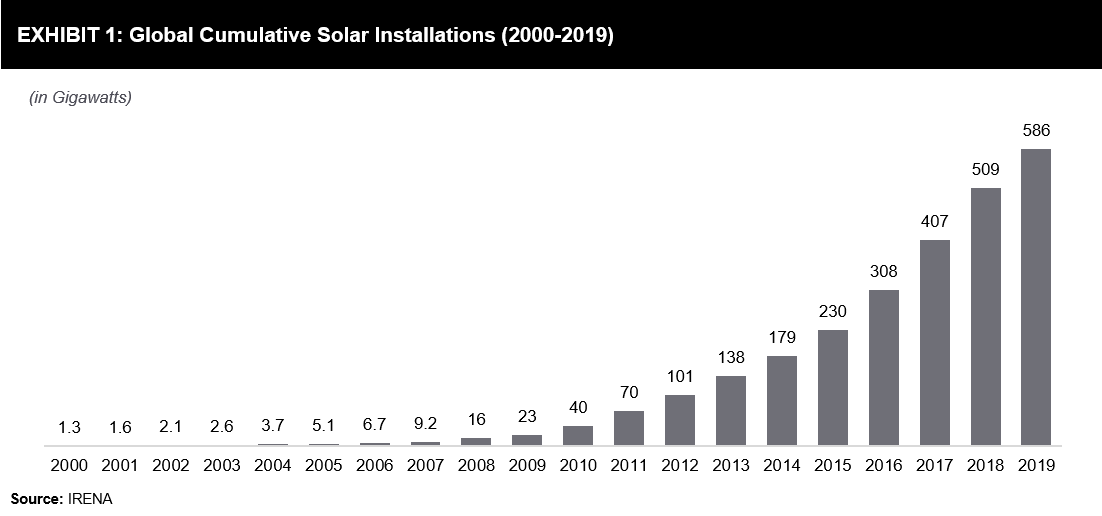
Solar panels can be classified into three generations. Crystalline silicon (monocrystalline / multi-crystalline); thin-film (amorphous silicon, cadmium telluride, and copper indium gallium selenide – CIGS); and concentrator photovoltaics (organic, dye-sensitized, and hybrid). Monocrystalline and polycrystalline silicon solar panels have higher conversion efficiency than thin-film solar cells. Therefore these are currently the most widely used commercial solar panel materials. Crystalline silicon panels hold a 95% market share of worldwide PV production, and thin film solar panels account for ~4.5%. On the other hand, third-generation solar panels have not yet been commercialized on a large scale. Crystalline silicon panels hold 95% market share of worldwide PV production, and thin film solar panels account for ~4.5%, while third-generation solar panels have not yet been commercialized on a large scale.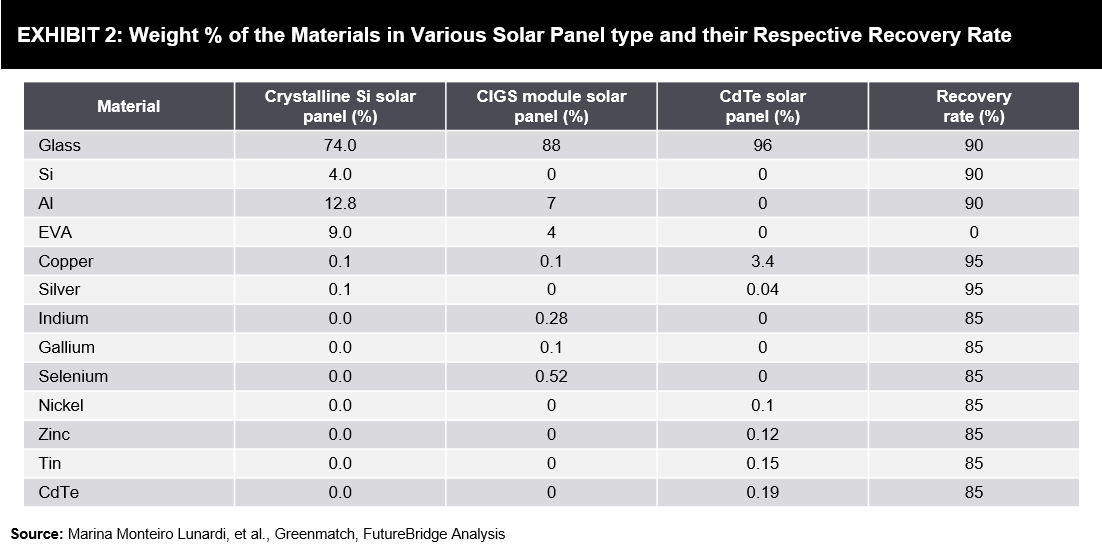
Solar panels contain valuable materials such as silicon, silver, aluminum, copper, and gallium and hazardous materials such as lead and cadmium, which are harmful to humans. From an economic perspective, it is quite significant to recycle valuable materials that can ensure the sustainability of the supply chain in the long term. Moreover, from the environmental protection aspect, recycling of solar panels not only prevents the release of hazardous substances from the waste streams but also reduces the greenhouse gas emissions related to the production of PV modules.
Solar Panels Waste Projections
Solar panel waste streams will increase alongside worldwide PV deployment. As shown in Exhibit 1, that global cumulative PV deployment accelerated after 2010 and has grown exponentially, reached 586 GW in 2019. The major global PV leaders today include China (205 GW of cumulative installed capacity), Japan (62 GW), the US (60.5 GW), Germany (48.9 GW), and India (34.8 GW).
Most waste is typically generated during four primary life cycle phases of solar panels: a) panel production, b) panel transportation, c) panel installation, and d) EoL disposal of the solar panel. It is assumed that waste generated during the production is easily managed, which is collected and treated by waste treatment contractors or manufacturers themselves.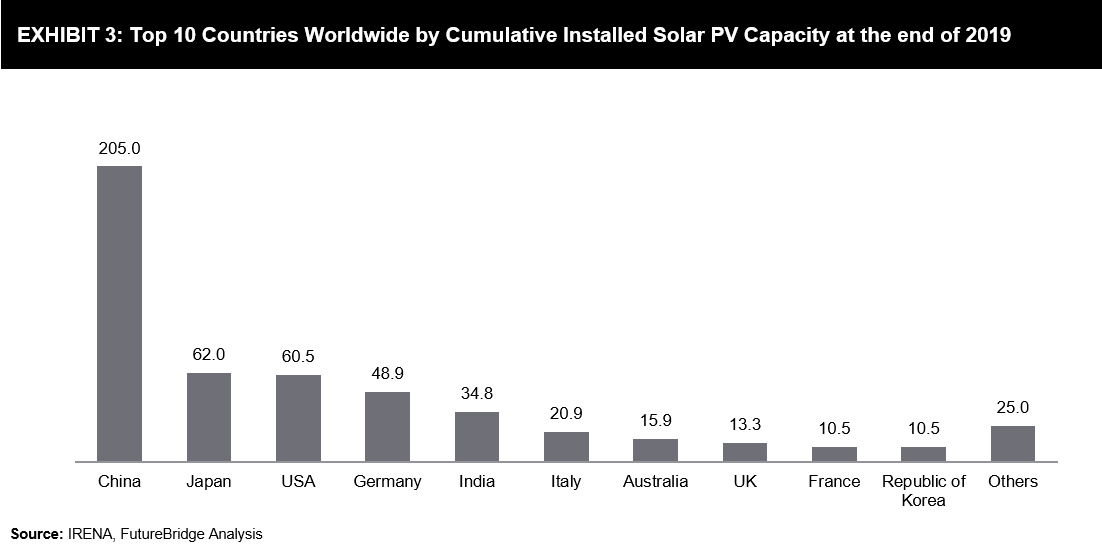
It is estimated that ~50 million tonnes of e-waste will be generated globally in 2020. By comparison, the solar panel waste will account for no more than 72,160 metric tonnes by the end of 2020. This represents only 0.1% of total e-waste today, but the amount of global waste from solar panels will rise significantly over the next 20 years. Exhibit 4 shows the solar panel’s waste projections by countries.
Considering the worldwide surge in PV deployment since 2010 and an average lifetime of 25 years for solar panels, waste volumes are certain to increase more rapidly after 2030, from 1.35 MMT to 12.3 MMT in 2040. In 2030, the top three solar panel waste countries are expected to include Germany (4,00,000 tonnes), China (2,00,000 tonnes), and Japan (2,00,000 tonnes), the picture will slightly change by 2040. By then, China is predicted to have accumulated the largest amount of waste (2.8 MMT), followed by Germany (2.2 MMT) and Japan (1.8 MMT).
The solar sector is expanding faster in the Asian region than anywhere else in the world, but no country in the region has adequate solar panel recycling laws. Except for the European Union (EU), no country in the world has passed laws/regulations on solar panel waste recycling to tackle the impending sharp increase in EoL PV modules.
In Europe, solar panels are officially regarded as Waste Electrical and Electronic Equipment (WEEE) by the EU commission, which means that solar panels waste must be collected and recycled in an appropriate way. Solar panels are subject to a statutory take-back obligation in Germany, which is regulated by the ElektroG.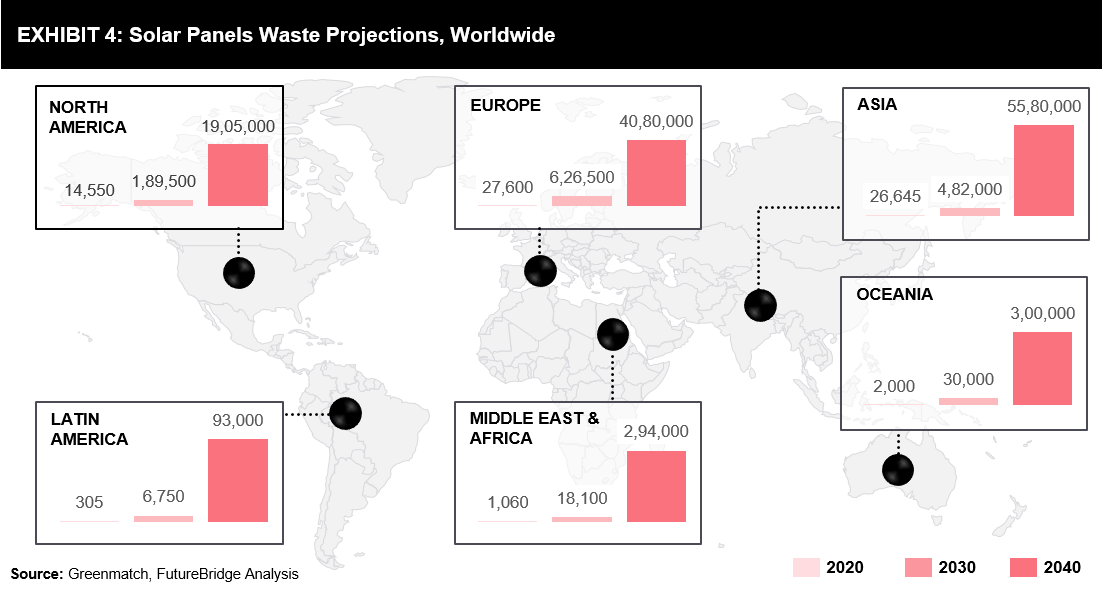
Solar Panel Waste Recycling Options
Currently, research and development into solar panels recycling are being carried out mainly in Germany, France, Italy, Japan, and the United States of America. Most efforts in this area are focused on Si panels to recover and recycle silicon and rare metal elements. Exhibit 5 shows the recycling technologies for the various kinds of solar panels. Currently, there are three methods, as physical, thermal, and chemical are the most prevalent for the recycling of solar panels waste. The large-scale recycling of Si solar panels and thin-film solar panels is well advanced, and they are currently recycled using a combination of mechanical and chemical treatments to achieve meaningful outcomes.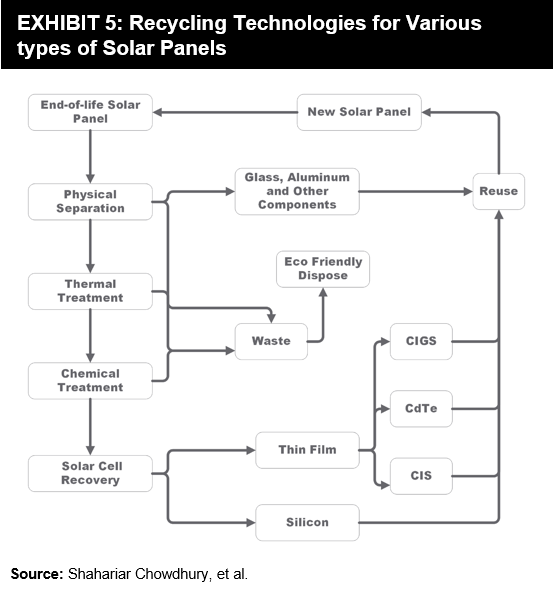 Exhibits 6 summarizes the recycling possibilities for solar panels, as well as the advantages and disadvantages of each process
Exhibits 6 summarizes the recycling possibilities for solar panels, as well as the advantages and disadvantages of each process
Value Chain
The solar panels recycling industry involves many different activities, from decommissioning of the solar panels to the collection, sorting, and recycling of solar panels. There are a limited number of companies that focus exclusively on solar panel recycling. Many newcomers are small corporations for whom solar panels recycling is the core market. First Solar is the vertically integrated player in this space to capture more stable value from the production of a solar panel to recycling (end-to-end recycling process). First Solar separates the cadmium telluride semiconductor materials from EoL solar panels (thin film-based) glass and polymer sheets, then reclaims and purifies the material for use in new panels. First Solar started recycling thin-film cadmium telluride solar panels in Germany (2005) and planning to include a recycling plant in Vietnam. In 2018, the French water and waste group Veolia had opened Europe’s first recycling plant for solar panels (crystalline silicon) to recycle 1,800 tons of material and is set to ramp up to 4,000 tons by 2022.
Drivers and Barriers
Developing an EoL management scheme for solar panel waste requires the balancing of several factors such as high collection rate, high recovery, and recycling targets, which are primarily driven by policy, economic, and market initiatives. Currently, the disposal of solar panels is not subject to specific regulation throughout the world, except EU, this means most of solar panels waste may end up in landfills. Solar panel recycling is not yet widespread worldwide; stakeholders within the value chain are busy laying the critical groundwork to build the necessary collection, management, and recycling systems, i.e., EoL management for solar panels. Exhibit 8 & 9 shows the key drivers and challenges for solar panels recycling.

Future Outlook
The future of solar panel recycling shows great promise as the solar energy market has grown significantly in the last ten years. With the increasing number of solar panels being sold and installed worldwide each year, solar panels are ending up in the waste stream. Recycling solar PV panels is the most sustainable solution in which solar panels can be handled at the end of their useful life, not only from an environmental and social impact perspective but also in terms of resource and economic efficiency. The recovered materials can serve the production of new solar panels or be sold into global commodity markets, hence, increasing the security of future raw material supply. Currently, only the EU has adopted solar panels-specific waste regulations that require 80% recovery and 75% recycling rate of solar panel waste. Most countries around the world classify solar panels as general or industrial waste. However, in the United States of America or Japan, general waste regulations may include solar panel testing for hazardous materials content as well as prescription or prohibition of specific shipment, treatment, recycling, and disposal pathways. Japan is the only Asian country that has made efforts to promote opportunities in solar panels recycling by subsidizing recycling equipment, although it has not mandated solar panel waste recycling.
International Renewable Energy Agency (IRENA) report estimates that the value of recovered raw materials from solar panels could increase cumulatively up to USD 450 million by 2030. This is equivalent to the number of raw materials currently needed to produce approximately 60 million new solar panels or 18 GW of power generation capacity. By 2050, the value of the recoverable materials could cumulatively exceed USD 15 billion, equivalent to 2 billion panels, or 630 GW. It is anticipated that a rise in the number of EoL solar panels across the globe will drive the solar panel recycling market in the next 10 to 20 years.
Connect with us to rediscover the dynamic landscape of solar panel recycling, exploring cutting-edge opportunities, innovations, and trends tailored to your business needs.







 Exhibits 6 summarizes the recycling possibilities for solar panels, as well as the advantages and disadvantages of each process
Exhibits 6 summarizes the recycling possibilities for solar panels, as well as the advantages and disadvantages of each process




































